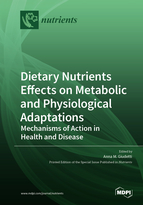Dietary Nutrients Effects on Metabolic and Physiological Adaptations: Mechanisms of Action in Health and Disease
A special issue of Nutrients (ISSN 2072-6643).
Deadline for manuscript submissions: closed (31 July 2021) | Viewed by 46376
Special Issue Editor
Interests: epithelial–mesenchymal transition; diabetes; lipid metabolism; mitochondrial carriers; obesity; thyroid hormones
Special Issues, Collections and Topics in MDPI journals
Special Issue Information
Dear Colleagues,
Changes in lifestyle and a shift from a traditional to an industrialized/westernized diet has drastically increased the rates of diet-related chronic disease. This has led to an unprecedented explosion in the prevalence of obesity and being overweight, cancers, and chronic and metabolic diseases.
The physiological mechanism of action of nutritional compounds is closely associated with their ability to recognize and modulate specific cellular enzymes or to affect the cell redox state. The identification of these targets is essential to recognize the mechanisms of action of nutritional compounds and their direct or indirect effects on cellular processes and functions in physiological and pathological conditions.
This Special Issue is dedicated to increasing and updating our knowledge about the association between dietary pattern and diet-related diseases. In particular, we intend to focus on the molecular, biochemical, and physiological processes underlying the mechanism of action of nutritional compounds and other dietary components. Studies aimed at characterising the chemical properties of nutrients and their analogues are also welcome. We look forward to significant contributions that will appeal to an international audience of researchers.
The following topics are of particular relevance and interest:
- The effects of nutrients on physiological functions and systems;
- The effects of nutrients in cellular reprogramming;
- The effects of nutrients on cellular and molecular processes;
- The effects of nutrients on energy homeostasis;
- The effects of nutrients on human diseases.
Dr. Anna M. Giudetti
Guest Editor
Manuscript Submission Information
Manuscripts should be submitted online at www.mdpi.com by registering and logging in to this website. Once you are registered, click here to go to the submission form. Manuscripts can be submitted until the deadline. All submissions that pass pre-check are peer-reviewed. Accepted papers will be published continuously in the journal (as soon as accepted) and will be listed together on the special issue website. Research articles, review articles as well as short communications are invited. For planned papers, a title and short abstract (about 100 words) can be sent to the Editorial Office for announcement on this website.
Submitted manuscripts should not have been published previously, nor be under consideration for publication elsewhere (except conference proceedings papers). All manuscripts are thoroughly refereed through a single-blind peer-review process. A guide for authors and other relevant information for submission of manuscripts is available on the Instructions for Authors page. Nutrients is an international peer-reviewed open access semimonthly journal published by MDPI.
Please visit the Instructions for Authors page before submitting a manuscript. The Article Processing Charge (APC) for publication in this open access journal is 2900 CHF (Swiss Francs). Submitted papers should be well formatted and use good English. Authors may use MDPI's English editing service prior to publication or during author revisions.
Keywords
- Dietary nutrients
- Human nutrition
- Metabolic pathways
- Human diseases
- Mediterranean diet
- Bioactive molecules
- Signaling pathways
- Analogues







